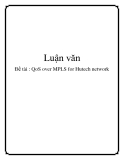
Multi-protocol label switching
-
Chuyển mạch nhãn đa giao thức MPLS (Multi-Protocol Label Switching) là một công nghệ đưa ra phương thức cải tiến cho việc chuyển tiếp gói tin qua mạng. MPLS là sự kết hợp giữa kỹ thuật định tuyến lớp 3 và chuyển mạch lớp 2 cho phép nâng cao tốc độ chyển tiếp lưu lượng trên mạng lõi và định tuyến tốt ở mạng biên bằng cách sử dụng các nhãn gắn thêm vào các gói tin. Ý tưởng chính của MPLS sử dụng nhãn gắn kèm với các gói tin để quyết định việc chuyển tiếp gói tin đến...
 18p
18p  nguyenquangha1991
nguyenquangha1991
 12-10-2012
12-10-2012
 550
550
 116
116
 Download
Download
-
Multiprotocol Label Switching Multiprotocol Label Switching (MPLS) is a standards-approved technology for speeding up network traffic flow and making it easier to manage. MPLS involves setting up a specific path for a given sequence of packets, identified by a label put in each packet, thus saving the time needed for a router to look up the address to the next node to forward the packet to. MPLS is called multiprotocol because it works with the Internet Protocol (IP), Asynchronous Transport Mode (ATM), and frame relay network protocols....
 78p
78p  greenwind007
greenwind007
 13-09-2012
13-09-2012
 154
154
 44
44
 Download
Download
-
Tổng quan về MPLS: Định tuyến IP truyền thống có nhiều giới hạn , từ vấn đề khả năng mở rộng cho đến việc quản lí lưu lượng và tích hợp các mạng lớp...
 16p
16p  congnghe08
congnghe08
 21-07-2011
21-07-2011
 199
199
 41
41
 Download
Download
-
Multiprotocol Label Switching (MPLS) là một cơ chế trong mạng viễn thông hiệu suất cao chỉ đạo các dữ liệu từ một nút mạng dựa trên tiếp theo trên nhãn con đường ngắn hơn là địa chỉ mạng lâu dài, tránh phức tạp tra cứu trong một bảng định tuyến . Các nhãn xác định các liên kết ảo (đường dẫn) giữa các nút xa xôi chứ không phải là thiết bị đầu cuối. MPLS có thể đóng gói gói tin của các giao thức mạng . MPLS hỗ trợ một loạt các công nghệ truy cập, bao gồm cả...
 92p
92p  abcdef_6
abcdef_6
 05-07-2011
05-07-2011
 514
514
 189
189
 Download
Download
CHỦ ĐỀ BẠN MUỐN TÌM
















